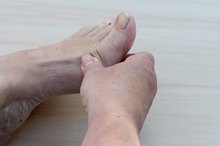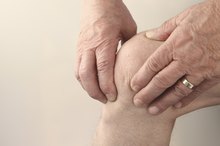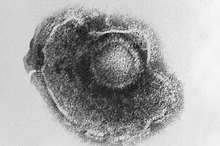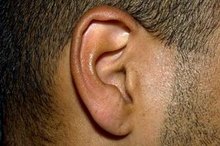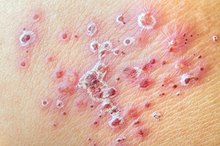Back Pain From Shingles
Shingles, a common name for herpes zoster, results from reactivation of the virus that causes chicken pox within sensory nerve roots of the back and spine. According to the National Institutes of Health, the name “shingles” comes from the Latin word “cingulum,” which means belt or girdle and connotes the virus’ preference for the back and trunk 2. Shingles produces a skin rash, as well as back pain that may be permanent for some people.
If you are experiencing serious medical symptoms, seek emergency treatment immediately.
Mechanism
Reactivation of the varicella-zoster virus inflames the sensory nerves, resulting in pain that seems to radiate from the back to the front of the chest. According to University of Alabama Medical School professor Richard J. Whitely, in some people, inflammation appears to sensitize nerves, so that pain sensations continue even after inflammation has resolved, a condition doctors call postherpetic neuralgia.
Timeframe
What Happens If Shingles Are Not Treated with Medicine?
Learn More
Back pain due to shingles usually begins two to three days before the appearance of a one-sided, blistering skin rash. The rash usually lasts seven to 10 days, but occasionally lasts two to four weeks. Back pain usually subsides as the rash starts to improve, except in people who develop postherpetic neuralgia.
- Back pain due to shingles usually begins two to three days before the appearance of a one-sided, blistering skin rash.
- Back pain usually subsides as the rash starts to improve, except in people who develop postherpetic neuralgia.
Prevalence
According to the National Institutes of Health, 25 percent of people develop shingles, usually after the age of 40 2. Shingles rarely recurs, except in people with immune system problems, such as AIDS or bone marrow transplant recipients. About half of people who develop shingles also develop postherpetic neuralgia.
Character
Neurological Disorders That Have Symptoms of Electrical Shock Feelings
Learn More
Back pain due to shingles usually begins as superficial, mild burning, tingling or itching. When the rash appears, pain usually becomes worse and may be severe. Pain seems to come from the skin and the touch of clothing or even a breeze may be sufficient to trigger shooting pains that interfere with activities. For people with postherpetic neuralgia, pain does not subside when the rash goes away.
- Back pain due to shingles usually begins as superficial, mild burning, tingling or itching.
- For people with postherpetic neuralgia, pain does not subside when the rash goes away.
Associated Symptoms
The skin rash caused by shingles is characterized by redness and blister-like eruptions confined to a single side of the body. Although shingles itself is not life-threatening, patients with postherpetic neuralgic often suffer from depression, sleeplessness, weight loss and disability.
Treatment
Antiviral drugs such acyclovir, valacyclovir and famcyclovir can reduce the duration and severity of acute shingles. Steroids quell lingering inflammation within the nerve roots. Antidepressants and anticonvulsants modify the transmission of pain signals. Narcotics send pleasure signals that cancel out pain signals. Topical agents usually involve delayed release of local anesthetics, such as:
- lidocaine
- that stop all signal transmission from the treated nerves
- including perception of temperature
- touch
- as well as pain
- Antiviral drugs such acyclovir, valacyclovir and famcyclovir can reduce the duration and severity of acute shingles.
- Antidepressants and anticonvulsants modify the transmission of pain signals.
Prevention
In May 2006 the U.S. Food and Drug Administration approved a varicella-zoster virus vaccine, Zostavax, for people 60 and older who have already had chicken pox.
Related Articles
References
- "Harrison's Principles of Internal Medicine, 23rd Edition;" A.S. Fauci et al.; 2008
- National Institutes of Health: National Institute of Neurological Disorders and Stroke: Shingles
- “Journal of Infectious Diseases;” Varicella-Zoster Virus-Specific Immune Responses; Veterans Affairs Shingles Prevention Study Group; 2008
- National Institutes of Health: National Institute of Neurological Disorders and Stroke: Shingles Information Page
- Centers for Disease Control and Prevention. Shingles (Herpes Zoster) Signs & Symptoms.
- Centers for Disease Control and Prevention. Shingles (Herpes Zoster) Signs & Symptoms.
- John AR, Canaday DH. Herpes Zoster in the Older Adult. Infect Dis Clin North Am. 2017;31(4):811-826. doi: 10.1016/j.idc.2017.07.016
- Yun H, Xie F, Baddley JW, Winthrop K, Saag KG, Curtis JR. Longterm Effectiveness of Herpes Zoster Vaccine among Patients with Autoimmune and Inflammatory Diseases. J Rheumatol. 2017;44(7):1083-1087. doi: 10.3899/jrheum.160685
- Cohen KR, Salbu RL, Frank J, Israel I. Presentation and Management of Herpes Zoster (Shingles) in the Geriatric Population. P T. 2013;38(4): 217-224, 227.
- Galetta KM, Gilden D. Zeroing in on zoster: A tale of many disorders produced by one virus. J Neurol Sci. 2015;358(1-2):38-45. doi: 10.1016/j.jns.2015.10.004
- Blank LJ, Polydefkis MJ, Moore RD, Gebo KA. Herpes zoster among persons living with HIV in the current antiretroviral therapy era. J Acquir Immune Defic Syndr. 2012;61(2):203-7. doi: 10.1097/QAI.0b013e318266cd3c
- Mallick-searle T, Snodgrass B, Brant JM. Postherpetic neuralgia: epidemiology, pathophysiology, and pain management pharmacology. J Multidiscip Healthc. 2016;9:447-454. doi: 10.2147/JMDH.S106340
- Johnson RW, Bouhassira D, Kassianos G, Leplège A, Schmader KE, Weinke T. The impact of herpes zoster and post-herpetic neuralgia on quality-of-life. BMC Med. 2010;8:37. doi: 10.1186/1741-7015-8-37
- Sampathkumar P, Drage LA, Martin DP. Herpes zoster (shingles) and postherpetic neuralgia. Mayo Clin Proc. 2009;84(3):274-80.
- Pereira LB. Impetigo - review. An Bras Dermatol. 2014;89(2):293-9. doi: 10.1590/abd1806-4841.20142283
- Gershon AA, Breuer J, Cohen JI, et al. Varicella zoster virus infection. Nat Rev Dis Primers. 2015;1:15016. doi: 10.1038/nrdp.2015.16
- Naveen KN, Pradeep AV, Kumar JS, Hegde SP, Pai VV, Athanikar SB. Herpes zoster affecting all three divisions of trigeminal nerve in an immunocompetent male: a rare presentation. Indian J Dermatol. 2014;59(4):423. doi: 10.4103/0019-5154.135548
- Opstelten W, Zaal MJ. Managing ophthalmic herpes zoster in primary care. BMJ. 2005;331(7509):147-51. doi: 10.1136/bmj.331.7509.147
- Jeon Y, Lee H. Ramsay Hunt syndrome. J Dent Anesth Pain Med. 2018;18(6):333-337. doi: 10.17245/jdapm.2018.18.6.333
- Kim SH, Choi SM, Kim BC, et al. Risk Factors for Aseptic Meningitis in Herpes Zoster Patients. Ann Dermatol. 2017;29(3):283-287. doi: 10.5021/ad.2017.29.3.283
- Saxena A, Khiangte B, Tiewsoh I, Jajoo UN. Herpes zoster encephalitis presenting as multiple cerebral hemorrhages - a rare presentation: a case report. J Med Case Rep. 2013;7:155. doi: 10.1186/1752-1947-7-155
- Teo HK, Chawla M, Kaushik M. A Rare Complication of Herpes Zoster: Segmental Zoster Paresis. Case Rep Med. 2016;2016:7827140. doi: 10.1155/2016/7827140
- American Academy of Dermatology. Cellulitis: Overview.
- American Academy of Ophthalmology. Herpes Zoster Ophthalmicus.
- Centers for Disease Control and Prevention. Shingles (Herpes Zoster): Clinical Overview. Feb 21, 2018.
- Mayo Clinic. Postherpetic Neuralgia. Sept 16, 2015.
Writer Bio
Heather Gloria began writing professionally in 1990. Her work has appeared in several professional and peer-reviewed publications including "Nutrition in Clinical Practice." Gloria earned both a Bachelor of Science in food science and human nutrition from the University of Illinois. She also maintains the "registered dietitian" credential and her professional interests include therapeutic nutrition, preventive medicine and women's health.

